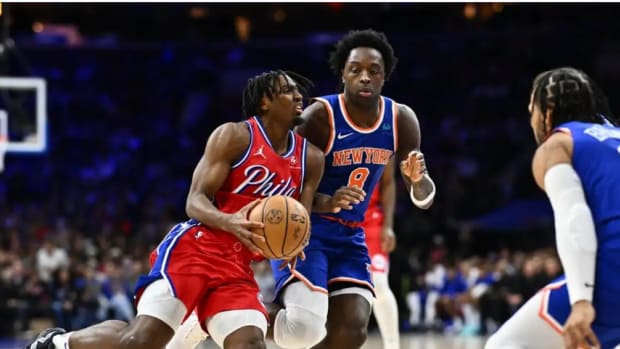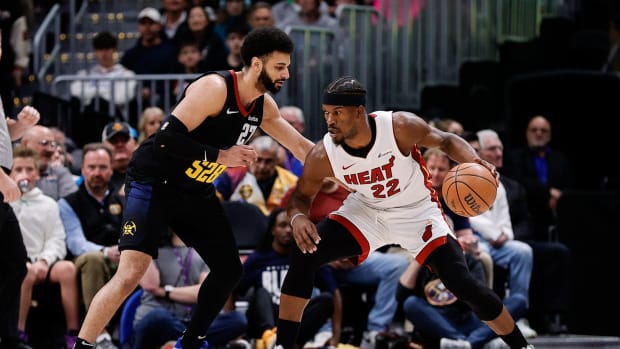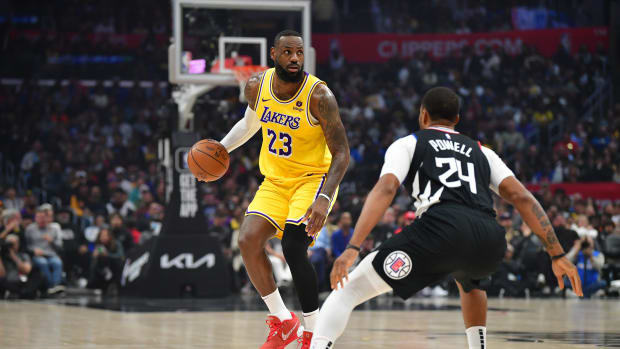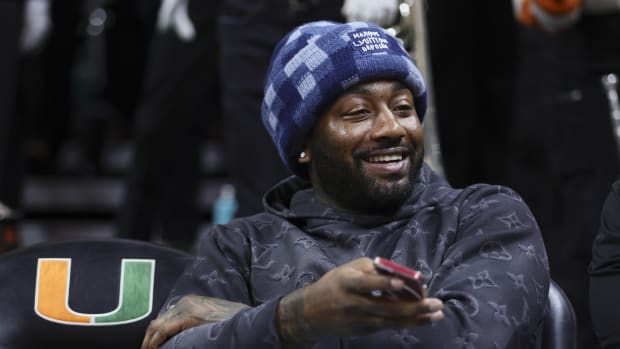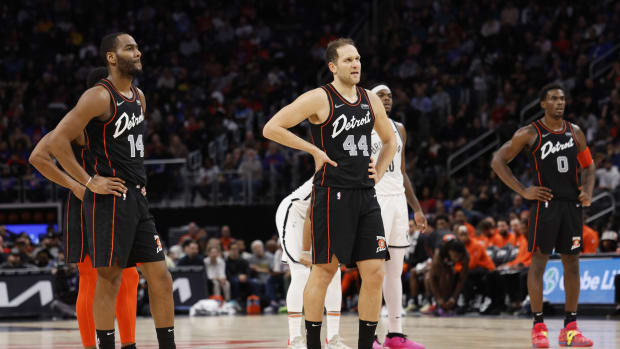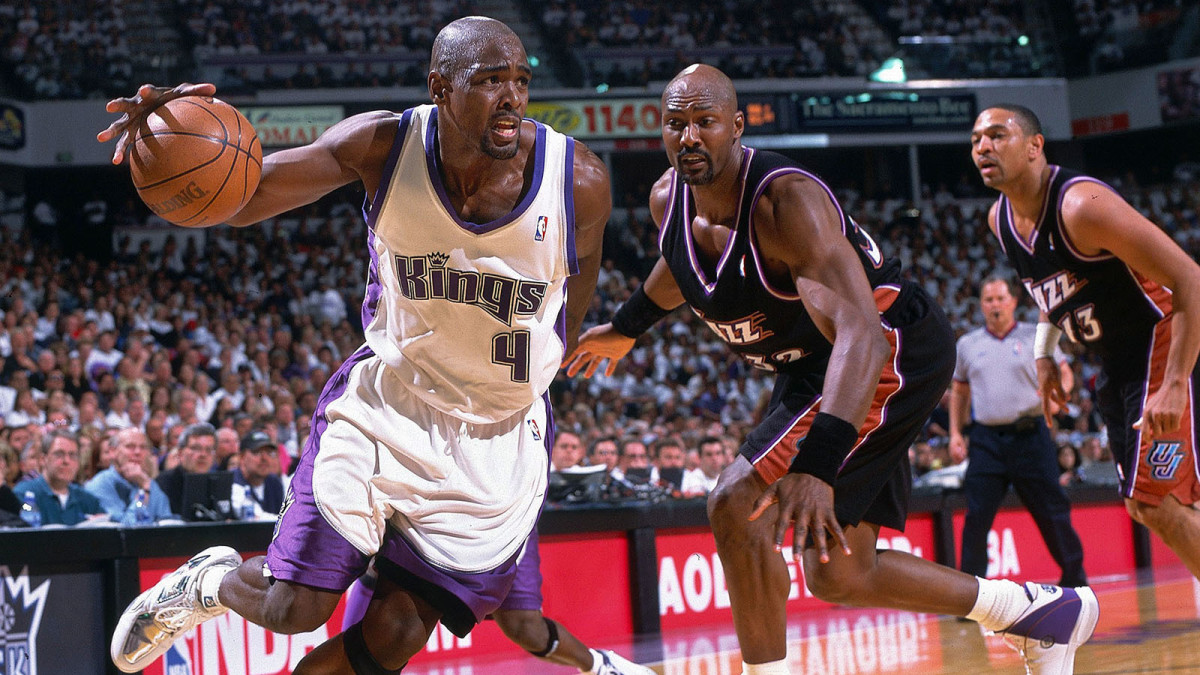
Chris Webber Was the Future of Basketball
It’s a tale as old as time: Each year, like clockwork, we see debates that it’s preposterous that _______ is just now making it into the Basketball Hall of Fame when ______ should have been inducted years ago.
As clichéd as that exercise has become, there’s an airtight case that Chris Webber—who will be inducted Saturday, eight years after he first became eligible—should never have waited this long. Really, he deserved to be a first-ballot member, if only because of how futuristic he was—both in his playing ability and in terms of his size-17 cultural footprint on the game.
The otherworldly ability was clear as early as middle school, when he first began playing the sport.
“I still remember seeing him for the first time: They’re showing clips on this highlight show, and on the screen you see this 6-foot-5, gangly eighth-grader at a small Christian school. He had 19 dunks in that game. He’d just grab a board, dribble down the floor and dunk,” says Kurt Keener, Webber’s high school coach at Detroit Country Day. “Usually, kids that size at his age are uncoordinated. But not Chris. He was at least a generation ahead in terms of the things he was able to do.”
Webber already had a certain ballhandling flair by the time he made it to high school, one he improved even more as he settled in and grew more comfortable. Keener, wanting to challenge his star pupil, told Webber of local legend Earvin “Magic” Johnson, and how Michigan State coach Jud Heathcoate would pair Magic with the club’s four weakest players for pickup games as a way to increase the difficulty for him. So Webber took the same approach as a high school big man in hopes of making his teammates better, to develop passing skills that were normally far more associated with guards. During shooting drills, coaches would also stand in front of Webber with plastic Wiffle ball bats extended in the air to force him to put more arc on his jumpers. Something else to juice the difficulty another notch.
By the time he walked out of Detroit Country Day, Webber was something of a celebrity: the winner of three state championships and, as a senior who averaged 29.4 points and 13.0 rebounds, the Gatorade National Player of the Year.
But it was at the University of Michigan that Webber became a true household name.
As a high schooler, he signed on to play for the Maize and Blue along with four other highly touted prospects—Jalen Rose, Juwan Howard, Jimmy King and Ray Jackson—in what would go down as one of the best recruiting classes in the history of the sport.
At the time the notion was pretty simple: Underclassmen generally waited their turn. Hell, take a quick glance at how the 1992 NBA draft played out. It was full of college seniors and a handful of juniors. Collegiate teams might have had an occasional freshman star, maybe even two of them. But it was unheard of to have three. Unthinkable to have four. Literally unprecedented to have five of them at once. (Now you occasionally see groups of high school All Americas teaming up to play for the same program.)
The Fab Five, as they’d famously be referred to, didn’t start the 1991–92 season on the floor together as a five-man unit. But within a couple of months, that became the norm. “At a certain point, I looked at our players and all the ability they had and asked, ‘What am I waiting for here?’ ” recalls former Michigan coach Steve Fisher, in terms of regularly starting that group together. “They just wanted to go out and win, and they were willing to put their egos aside to do it. And the same was true of Chris.
“Yeah, there were times you occasionally had to slow him and the other guys down, and tell them to take a breath. But it didn’t make sense to hold Chris back if he wanted to take occasional threes, or just dribble the ball down the floor. He never wanted to be a center. He just wanted to go out and be a dominant basketball player.”
Webber was the most dominant player from the most dominant recruiting class in the sport at the time, one that earned back-to-back trips to the NCAA Championship game in 1992 and ’93, when the core players were freshmen and sophomores. (Michigan fell to Duke in ’92, and came up heartbreakingly short against North Carolina in ’93 after Webber mistakenly called a timeout the Wolverines didn’t have in one of the more memorable moments in the tournament’s history.) But more than anything, those teams stood out because of what they represented. The brash, flamboyant playing style. The shaved heads. The black socks. The baggy shorts that were night and day from the John Stockton–era ones so many others wore.
Webber and his Wolverine teammates—who helped the school sell more merchandise than it did when Michigan won the national title in 1989—loudly ushered in a new, polarizing culture for the sport that would then influence the NBA just as much in the years to come.
Few players have been more intertwined with collegiate basketball history than Webber. And that’s without even taking into account his run-in with the NCAA—which played a part in Michigan going on probation and vacating its records from those Final Four runs—after it was established that he’d taken hundreds of thousands of dollars in loans from booster Ed Martin before turning professional.
But in hindsight, even that issue was ahead of its time. Now, some 30 years after that team’s genesis, college players that collectively bring in billions for their schools are being paid for their likenesses. There’s no telling how much money players from an iconic team like the Fab Five would have brought in—some athletes already generate six- and seven-figure sums, and we’re just getting started—but it may have been enough incentive to stop Webber and other high-profile stars from entertaining the boosters’ whispers.
The start of Webber’s NBA career had a crazy, modern-day start to it, too. The Magic, who already had Shaquille O’Neal from having won the draft lottery the year before, won it again in 1993, and had the draft rights to Webber. But they sent him to the Warriors, who in turn gave up one of the biggest draft hauls ever—four first-rounders, including the rights to Penny Hardaway—to land Webber.
But Webber despised coach Don Nelson, so much so that he made use of an unusual-for-the-time clause in his deal, which allowed him to opt out after the first year of his contract. So Webber, after earning Rookie of the Year and winning 50 games in Year 1, forced a sign-and-trade deal to Washington.
Webber’s move, which took place at a time when player empowerment was still a bit of a foreign concept, drew barbs in the media, with some calling the star spoiled. (Interestingly enough, Nelson lost his hold on the Golden State job shortly afterward, then got ousted less than a year into his next gig with the Knicks after falling out with most of his players in New York.)
While he got to team up again with Howard in the nation’s capital, Webber’s run in D.C.—statistically successful at 20.9 points, 9.7 boards and 4.4 assists—yielded zero playoff victories in four seasons there. So the Wizards dealt him to Sacramento, which might as well have been Siberia, in May 1998.
During his first plane ride into Sacramento as a Kings player, a 25-year-old Webber looked out his window to find ample farmland and cows on the horizon. It wasn’t somewhere he wanted to be.
“I was crying. Crying like a baby,” he said in a 2000 interview, adding that he sat in former teammate Billy Owens’s car and sobbed over his new reality. “It felt like the NBA had banished me to Sacramento.”
It wasn’t far off from the reaction star Mitch Richmond—who was traded for Webber—had when he was initially sent to the Kings in 1991. “I walked in [the locker room], and the first thing I hear from one of the players is, ‘Welcome to hell.’ And I’m like, ‘Ah, s---,’ ” Richmond recalled during a podcast with Tom Haberstroh last year.
By the time Webber arrived in Sacramento, the Kings had made the playoffs just once in the 12 years before. Webber made it known to anyone who’d listen that he didn’t want to play there—enough to where those in his corner told him to be more judicious with what he was saying.
“I kept telling him: If God sent you there, there’s a reason he put you there. You just need to find out why,” says Nedra Keener, the wife of Webber’s high school coach. She said the talk reminded her of one she’d had with Webber in his high school days. Webber was initially unhappy at the private Detroit Country Day, because he’d wanted to play at Southwestern High with Rose, who he’d always been close with.
Much to Webber’s surprise, the Kings—with Vlade Divac, Jason Williams, Mike Bibby, Peja Stojaković and Hedo Türkoğlu—would become the best stylistic fit he ever enjoyed in the association. At its peak, the team had a great defense, and perhaps the most fun, explosive offense in the league. The Kings—led by coach Rick Adelman, who also gets inducted into the Hall this weekend—had a Globetrotter-like flair. Assistant Pete Carril, known for his pass-happy Princeton offense, was brought in to infuse his attack, which would be led by Webber, Williams and Divac. And while Webber had concerns his game would go unrecognized in one of the league’s more mundane markets, his mark as a playmaking big man was appreciated more there than it ever had been during either of his previous stops. In futuristic fashion he logged more triple doubles than any other NBA big as a King. (Even when counting the entire league, only passing savant Jason Kidd had more triple doubles than Webber in that span, according to Stats Perform.) And Webber finished in the top 10 of MVP voting every season for five straight years.
“By the end of his time there, I don’t think anyone loved [Sacramento] more than Chris,” teammate Jon Barry says.
The Kings won 50 games or more five years in a row, including in 2001–02, when they won an NBA-best 61. (From ’01 to ’05, Sacramento’s 280 regular-season wins were the second-most in the NBA, trailing only the Spurs’ 292.) They lost to the Kobe- and Shaq-era Lakers in a controversial seven-game conference finals series in ’02, one that felt more like the NBA Finals than the actual NBA Finals did. Since Webber’s exit from Sacramento in ’05, the Kings have made the playoffs just once, and are currently tied for the longest playoff drought in NBA history, at 15 years and running.
When Webber’s basketball career ended in 2008, there was a soft landing for him on the broadcast-media side—something he’d actually prepared for back in high school after practices with Keener. The two would sit in Keener’s office every day after workouts and do make-believe media sessions on tape, then watch them back and critique Webber’s performance and responses. After a while, the coach figured that would be a better use of the star’s time, knowing he could only do so much to challenge him on the court.
“I think we’d all love to say that we got Chris and made him into what he was,” Keener says. “But he was already a diamond by the time I got him.
“If anything, all I did was polish him up some.”
Hall of Fame players are special. But ones like Webber, who showed us time and again what the future would look like, are even more rare.
More NBA Coverage:

































